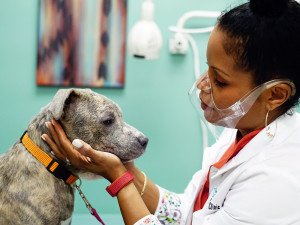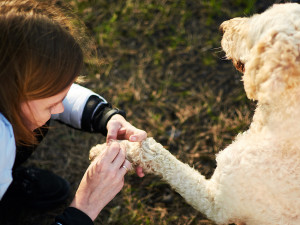Can Dogs Get Skin Tags? Causes and Treatments
Yes, and here’s why you shouldn’t pick at them, even if you want to.

Share Article
In This Article:
What Are Skin Tags on Dogs? What Causes Skin Tags on Dogs? Diagnosing Skin Tags on Dogs Are Skin Tags on Dogs Dangerous? How to Remove Skin Tags From a Dog
Just like humans, dogs can develop skin tags, which are small, soft, and typically harmless growths that appear on various parts of the body. While skin tags in dogs are generally benign and don’t require treatment, it’s important for pet parents to differentiate them from other skin conditions.
What are skin tags on dogs?
Skin tags on dogs seem to pop up out of nowhere. Most dog parents would swear that their pup’s coat and skin were perfectly smooth the day before, then a little mass suddenly sticks its head up out of nowhere.
Skin tags are known medically as arcochordons — or fibroepithelial — polyps. They’re generally benign growths that can show up anywhere on a dog’s body, but they’re seen most commonly on the legs. Skin tags can appear as a single nodule or be clustered together in groups. They’re usually the color of the dog’s skin: pinkish in some dogs or areas, and black in others. They can be pedunculated (hanging like a flap from the skin’s surface) or feel more firmly attached to the skin. Skin tags are usually small (less than a centimeter in any direction) but can grow to be larger.

What causes skin tags on dogs?
No one knows for sure what causes a skin tag on a dog to show up. Despite this uncertainty, there are a few predisposing factors that have been linked to the development of these little masses.
Some possible causes for skin tags include:
Friction and irritation
Rubbing can damage skin cells or lead to broken hairs and clogged hair follicles. This type of chronic irritation can increase the chances that skin cells will heal poorly and develop small masses. Skin tags are commonly found on the underside of the chest in some deep-chested breeds like Greyhounds and Doberman Pinschers. This is thought to be due to increased friction and pressure on the skin over their sternum when they lay down.
Age
Skin tags can be found in dogs of any age but occur more commonly in dogs greater than five years old. With age, there is more time for chronic irritation and injury to occur, increasing the odds of a skin tag developing.
Sex
Both male and female dogs, whether or not they’re spayed or neutered, can develop skin tags. These masses seem to occur more frequently in male dogs, but it’s unclear if this is due to a difference in hormones, chromosomes, or lifestyle.
Obesity
Obese dogs may be more likely to develop skin tags because their increased weight and size means more chances for rubbing against things and more pressure on their skin whenever they lay down.
Parasites or allergies
A firm link between parasites or allergies and skin tags has not been established. It’s possible that the chronic skin irritation, increased risk of infection, and repeated trauma of chewing and scratching could lead to more skin tags, especially in problem areas.
Diagnosing skin tags on dogs
Although skin tags are usually benign, it’s best not to assume a new growth on your dog’s skin is just a skin tag and ignore it completely. While a true cancerous skin tag on a dog is rare, there are many other masses that can look similar to skin tags. These lesions could have the potential to cause problems for your dog. Some common skin lesions that look similar to skin tags include:
Warts
Warts in dogs are most commonly caused by papillomavirus. They are small skin growths that can look like skin tags, but usually have a more roughened appearance to their surface. Warts may resolve on their own as the immune system takes care of the virus, but some will require removal if they are causing issues for the dog.
Tumors
There are numerous tumors, both benign and malignantopens in new tab, that can look like skin tags. You can’t assume that a mass is benign just because it appears small: some masses can travel deep beneath the skin or spread to lymph nodes. Benign tumors, like hemangiomas, are often confused with skin tags because they can have a similar appearance to black skin tags on a dog.
Ticks
Be sure to positively identify a tick before you try pulling it off. More than one pet parent has given their dog an unpleasant surprise by yanking on something that looked like a tick but was quite attached to their pup’s skin.
Nipples
Many pet parents have attributed all sorts of worries about skin problems to perfectly normal nipples. This is especially common with new dog parents adopting an older, female dog who has nursed litters previously. After the hormonal changes associated with pregnancy and nursing, the nipples may not return to their previous size and could look like a long skin tag.
Are skin tags on dogs dangerous?
True skin tags on dogs aren’t generally dangerous. As long as they’re benign, they’re not expected to bother your dog and shouldn’t interfere with their overall health. There are a few situations where a skin tag could cause issues, though.
They’re in a location that sees a lot of trauma.
Skin tags on high-pressure areas, like the elbows or lower chest, are more likely to get abraded and bleed.
They’re on dogs with allergies or parasites.
Repeated chewing or scratching of areas with skin tags can result in self-trauma that damages skin tags.
They’re on dogs with parents who need to fidget.
Some dog parents can cause irritation of skin tags by constantly playing with them or pulling on them. Just leave it alone and give your pup the good pets they want.
They get infected.
Some tags that get injured or abraded can end up developing an infection. This can cause local swelling, an abscess, or an open wound.
When to seek veterinary attention.
It’s always a good idea to inform your veterinarian of any new skin lesions that you find. You can always call or send an email with a picture to let them know what you’re seeing. They can guide you on what to do. They may advise you to come in to have it checked soon, or they may feel it’s OK to wait until your dog’s next check-up to take a closer look at it.
How to remove skin tags on dogs
The number-one thing to remember is not to remove skin tags at home. No matter how flimsy they feel, skin tags are firmly attached to the skin and usually have a good blood supply. Dog skin tag removal should be done by a veterinarian so that the mass can be removed safely without pain and sent to a pathologist to confirm it’s benign.
Depending on the location and appearance of the skin tag, your veterinarian may offer a few different options, such as:
Monitoring without intervention
If the mass is in an area that isn’t expected to cause problems, isn’t bothering your dog, and isn’t growing, your veterinarian may offer the option of watchful waiting. They’ll have you monitor at home to make sure the skin tag doesn’t change in appearance. This option has some uncertainty because you won’t know for sure that the tag is benign.
Immediate surgical removal
Your veterinarian may offer the option of taking the mass off quickly. Depending on the location and size of the skin tag, this may be able to be done with sedation and local anesthesia only. It’s always best to have the removed tissue evaluated to make sure it’s benign.
Delayed surgical removal
In some cases, your veterinarian could offer to remove the mass next time your dog is having a procedure (often a dental evaluation and cleaning). Pairing skin tag removal with other procedures can help to cut down on cost and stress for your dog.
FAQs (People also ask):
What causes skin tags on dogs?
The exact cause of skin tags on dogs is uncertain, but they may be related to chronic irritation or trauma to the skin. This can occur in areas that see a lot of rubbing or pressure, or due to allergies or parasites.
How do I relieve dry skin on my dog?
If your dog is suffering from dry or flaky skin, talk to your veterinarian about options. They can help rule out problems like bacterial or yeast infections and may recommend products to help restore your dog’s shiny coat.
What does a skin tag look like on dogs?
Skin tags are usually small, raised masses coming from a dog’s skin. They’re generally soft, non-painful, and easily moveable. They can be pink or black in color, depending on your dog’s skin pigment.
References:

Dr. Bartley Harrison, DVM
Dr. Bartley Harrison is a veterinarian with more than 19 years of experience. He has treated a variety of species in emergency and speciality practices for both large and small animals. His primary interests as a vet are emergency medicine and critical care.
Related articles
![A wheaten terrier getting a haircut to remove the hair from over his eyes]()
10 Best Grooming Products for Your Pup
Tools to keep your pet looking so fresh and so clean, from bamboo hair brushes to biodegradable wipes.
![greyhound dog being washed in tub]()
Lather, Rinse, Repeat: The Ultimate Dog Grooming Guide
Keep your dog well-groomed but trust trims to the pros.
![Dr. Joya, a vet, wearing a clear plastic mask and holding a gray dog with mange's head in her hands in the vet office]()
Dr. Joya Griffin Is Poppin’ Puppy Pimples on TV
The star of National Geographic’s Pop Goes the Vet on the understated specialty, reality TV, and finding fun in the gross.
![A Jack Russel terrier licking its front paw on dog bed.]()
Everything You Need to Know About Lick Granulomas
Acral lick dermatitis is a frustrating skin condition, but new treatments offer hope.
![Cute weimaraner dog lying on lawn and scratching its back]()
Best Allergy Medicines That You Can Give to Your Dog
Here’s what works (and what doesn’t).
![A woman checking out her dogs paw.]()
Here’s Where Disease-Carrying Ticks Are in the US—And How to Keep Your Pup Safe
Simple preventive steps can go a long way toward offsetting their threats.











